ART INSIDE CHAOS
New Routes to Creativity and Learning
Eleonora Bilotta, full Professor of Psychology, Università della Calabria, via P. Bucci, cubo 17/B, 87036 Arcavacata di Rende – Cosenza, Italy. E-mail: bilotta@unical.it.
Pietro Pantano, full Professor of Mathematics, Università della Calabria, E-mail: piepa@unical.it.
Francesca Bertacchini, Ph.D student, Università della Calabria, E-mail: fbertacchini@unical.it
Lorella Gabriele, post-doc researcher, Università della Calabria, E-mail: lgabriele@unical.it
Assunta Tavernise, contract researcher, Università della Calabria, E-mail: tavernise@unical.it.
ABSTRACT: In this paper an innovative Edutainment (education plus entertainment) laboratory on Chaos for high school students is presented, promoting the awareness that art and contemporary science have a common matrix. In particular, the setting foresees the physical construction of Chua’s circuit, its simulation on a computer, as well as the production of three-dimensional attractors and music. The software that allows the visualization of chaotic phenomena and their use as artistic products is “Chaos Explorer”, and it has been ideated, designed and realized by Evolutionary Systems Group at Università della Calabria (Italy). An experimentation involving Leonardo’s network is in progress.
Keywords: learning, education, Chaos, Edutainment, laboratory teaching.
Introduction
Chaos, one of the most important focus of contemporary science research [1, 2], has a great value in education [3, 4], even if its learning in high school classes is still not foreseen by current school year programs [5]. However, in recent years, some studies on the relationship between learning and Chaos have been carried out [6, 7, 8, 9], and important researches have involved high school students [10, 11]. In particular, the study leaded by Evolutionary Systems Group (ESG) has aimed at applying a teaching/learning model based on the idea that artifacts (also digital ones) can increase students motivation, stimulating the learning process and learners’ creativity. Moreover, ESG has demonstrated that these artifacts can be a powerful mean to explore the interplay between Science & Art. In fact, while scientists find often in the art field an ideal place to communicate their achievements, several artists draw inspiration from science exploring different disciplines as, for instance, biology [12, 13]. Hence, there is a deep analogy between the work process of scientists and artists: both observe and interpret the perceived world in order to comprehend fragments of reality [14, 15]. Furthermore, digital tools give to the artists the opportunity to renew and revitalize their creativity by producing original artistic products such as 2D and 3D images or music [1, 2, 16, 17, 18].
In this work, an Edutainment Laboratory on Chaos is introduced (section 2), realized thanks to a digital tool, the software Chaos Explorer (section 3). Finally, a reflection on the proposal to share the imaginary universe of Chua’s attractors with artists is presented (section 4).
The Edutainment Laboratory on Chaos
Is science boring? If students have the opportunity to use computer applications in order to virtually manipulate contents like images, sounds and music, their motivation increases and they declare to be favorably disposed towards the study of science [19, 20]. Because learning science can be fun and engaging. As a starting point, it has already been demonstrated that in the educational process Information and Communication Technologies are cognitive amplifiers and that they enhance the approach of young generation to scientific topics. Moreover, the experience of the beauty, simplicity and creativity of Digital Art implies a reduced mental effort in the learning of difficulty of scientific topics. Therefore, a non-conventional didactic environment in which art and science cause an effective “Edutainment” (the word is the result of the mixture of the two terms “education” and “entertainment”) has been planned by ESG. The main objective of this laboratory has been the design of an alternative model of learning process, based on the idea that students have to be emotionally involved and interested in the topic they have to learn. Thus, motivation and creativity must be increased through built ad hoc tools and contents: by exploring and modeling the patterns of Chua’s attractors, users have had the possibility to transform mathematical models into artistic products as images, sound and music.
The laboratory setting (Fig. 1) has foreseen:
1) the physical construction of Chua’s circuit (real manipulation);
2) its simulation on a computer screen (virtual manipulation);
3) the realization of three-dimensional attractors and the production of music and sound thanks to the software “Chaos Explorer” (virtual manipulation).
Following this approach and the planned hands-on activities, students have discovered how chaos-related concepts are simple. In fact, the direct interaction with (real/virtual) objects has encouraged learners to think, to infer, to formulate hypotheses and to test them through experimentation.
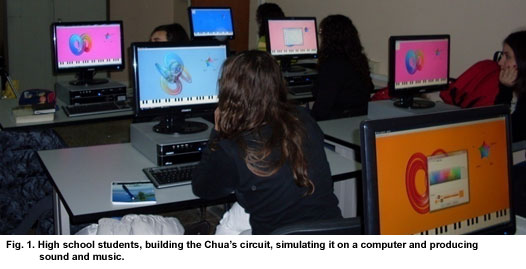
ESG has also developed a website on Chua’s circuit (http://chua.unical.it/), in which it is possible to:
- build virtually the Chua’s circuit through a software application, with an interface (Fig. 2) explaining all the circuit’s electronic components and the step-by step recipe, useful to model it;
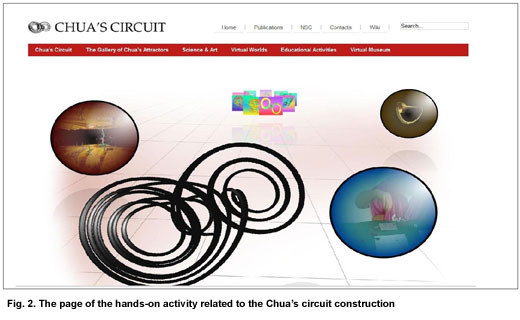
- visit the "Gallery of Chua's attractors", a collection of 3D models;
- look at a short movie on the "City of Imagination", where the Chua’s attractors stand for non-traditional buildings, disposed in the environment;
- explore 3D futuristic spaces, where dynamical systems are the foundations of multidimensional artificial worlds;
- admire a collection of chaotic attractors, realized as flower-like drawings, Pollock like-paintings, and geometrical configurations;
- visit the virtual museum of Chua's attractors, realized as a navigable interactive application, with an avatar helping in the exploration of the exhibition.
The software for realizing artistic products: Chaos Explorer
The software Chaos Explorer (Fig. 3) allows the visualization of chaotic phenomena related to all classes of Chua’s systems, their statistical analysis, and the investigation of changes in patterns, as the systems evolve. In particular, since in Chaos Explorer a mathematical model simulates Chua’s circuit, data derived from the simulation of the model are encoded and then converted into images, sounds and music through a series of computer algorithms. The manipulation of parameters is achieved through a very simple and intuitive interface. In fact, when the vertex of a star configuration is moved, the attractor shape changes; therefore, when one of the five provided parameters changes, the shape of the attractor varies significantly. Thus, very small modifications of parameters change radically the structure of the obtained attractor.

For the realization of Chaos Explorer, ESG has faced many different issues:
- to find general principles that drive the behavior of chaotic systems;
- to individuate common structures that, apparently, different systems share;
- to identify different levels of scale in which the chaotic behavior emerges;
- to discover temporal biological rhythms in relationships to the morphological structures that these systems manifest;
Moreover, in studying how to make visible the dynamics of Chua's circuit through computational models, ESG has taken into account the basic features of chaotic nature, such as the sensitive dependence on initial conditions, the fractal structure, and the qualitative transformations of behavior.
Further developments have led researchers of the ESG group to investigate a new class of systems, Chua’s machines attractors [21]. These systems have a computational nature and manifest a very surprising behavior, with the emergence of completely unexpected forms, as shown in Figures 4, 5 and 6.
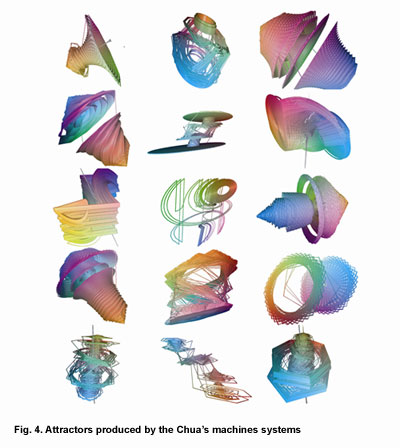
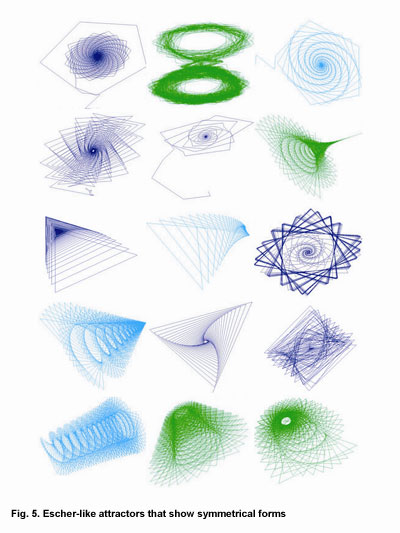

The beauty of these images has inspired the creation of various artistic artworks, as shown in Figure 7, that have been presented at different international conferences [22; 23; 24].
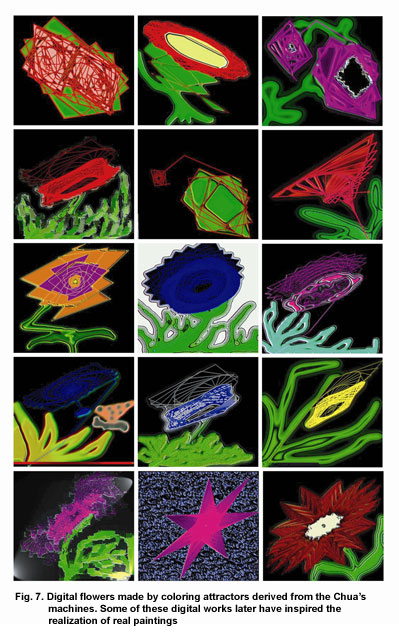
Many other design objects have been built, such as jewels and small sculptures, as it is possible to see in Figure 8.
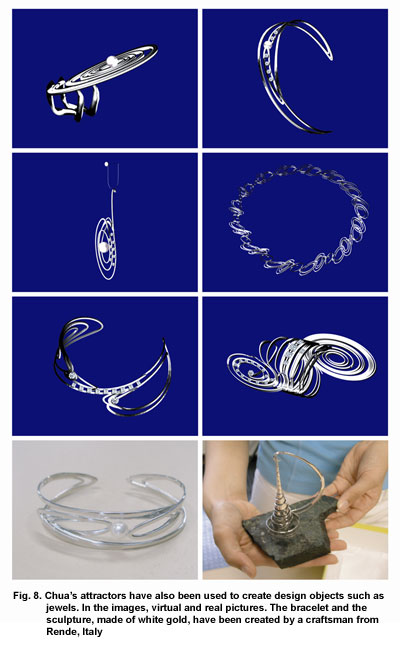
In short, we can summarize ESG Science & Art routes as follows:
- a series of theoretical research has led some researchers in the group to identify a variety of strange attractors, derived from the Chua's circuit;
- these attractors have been represented in the form of images, sounds and music by computational algorithms, embodied into software applications;
- from these applications, art forms such as 2D and 3D images, sound and music compositions have been produced.
The research group has also created a series of artistic products like design elements, logos and other visual communication tools, new musical instruments, software environments for sound and music production, as well as prototypes of video games. Another representation of the attractors in interactive contexts, has then allowed the building of virtual imaginary environments and multimedia theater performances [5, 16, 19, 25, 26, 27, 28, 29, 30].
Artists meet Chaos
ESG, in collaboration with LEONARDO, has decided to share the created “artificial experimental universe” of Chaos with artists, allowing them to explore, manipulate and study how to advance their theoretical and experimental investigations. An interesting experimentation is in progress, aiming at:
- promoting a more comprehensive frameworks for visualizing and translating into sound and music chaotic behavior;
- investigating how to apply findings from human psychology to data visualization and auralization;
- considering the nature of chaotic data and the tasks artists want to perform with the data;
- analyzing the need of the pre-processing of data;
- considering the strengths and limitations of different displays techniques, for example developing different visualizations of the same data;
- advancing multidimensional visualization for 4D attractors;
- considering the translation of attractors into physical media, such as for jewelry and sculpture;
- developing new interfaces for chaos-based artistic applications.
Blackwell and Green’s [31] cognitive dimensions questionnaire will be used for the evaluation. The web site of the experimentation can be found at the following webaddress: http://esg.unical.it/leonardo/.
Conclusions
Since Chaos grasps many phenomena of real life, it is considered one of the most extraordinary topics in contemporary science. However, it is still unknown to many scientists and to the wide public. Until recently, it was thought that the strange attractor, known as the Lorenz butterfly, was the only example of chaotic phenomena. Subsequently, the invention of Chua’s circuit has demonstrated the existence of many attractors. Starting from the known Chua’s attractors, nearly a thousand new chaotic attractors have been found by ESG [2]. The same research group has also developed visualization and sonification systems that allow the creation of new representations of chaotic patterns. Moreover, the beauty of these patterns has enabled the realization of artistic "objects", such as paintings, sculptures, jewelry, design elements as well as sound and music. What will happen if these computational systems will be provided to artists? Will they use the Chua’s attractors for aesthetic purposes? In what way will artists be able to grasp the elusive nature of chaotic phenomena and return it to our perception by artistic forms? ESG hope that the investigation of Chaos realized by artists will allow the emergence of complex representations of Art & Science that, in turn, will improve the knowledge of challenging phenomena in contemporary science.
References
[1] E. Bilotta, P. Pantano, F. Stranges, “Computer Graphics meets Chaos and Hyper chaos. Some key problems,” Computer &Graphics Vol. 30, No. 3, 359-367 (2006).
[2] E. Bilotta, P. Pantano, A Gallery of Chua’s Attractors (Singapore: World Scientific Series on Nonlinear Science, 2008).
[3] L. J. Cronbach, “Playing with Chaos,” Educational researcher Vol. 17, No. 6, 46–49 (1988).
[4] E. Bilotta, S. Gervasi, P. Pantano, “Reading Complexity in Chua’s Circuit by Music-Part I: a new way of understanding chaos,” International Journal of Bifurcation and Chaos Vol. 15 No. 2, 253-382 (2005).
[6] G. A. Cziko, “Unpredictability and indeterminism in human behavior: Arguments and implications for educational research,” Educational Researcher Vol. 18, No. 3, 17-25 (1989).
[7] J. Trygestad, “Chaos in the classroom: an application of Chaos theory,” 1997, http://www.eric.ed.gov/PDFS/ED413289.pdf, last accessed 1 October 2011.
[8] R. C. Pouravood, “Chaos, Complexity, and Learning Community: What Do They Mean for Education?,” School Community Journal Vol. 7, No. 2, 57-64 (1997).
[9] F. W. Markham, “A Method for Introducing the Concepts of Chaos Theory to Medical Students,” Theoretical Medicine & Bioethics Vol. 19, No. 1, 1-4 (1998).
[10] G. Gandhi, B. Muthuswamy, T. Roska, “Chua's Circuit for High School Students,” International Journal of Bifurcation and Chaos, 12, 2007, http://inst.eecs.berkeley.edu/~ee129/sp10/handouts/ChuasCircuitForHighSchoolStudents-PREPRINT.pdf, last accessed 1 October 2011.
[11] E. Bilotta, E. L. Bossio, P. Pantano, “Chaos at school: Chua’s Circuit for Students in Junior and Senior High School,” International Journal of Bifurcation and Chaos Vol. 20, No. 1, 1-28 (2010).
[12] G. Careri, “Discovering by Perceiving in art and in Science,” Leonardo Vol. 27, No. 3, 181-182 (1994).
[13] I. Alfano, M. Carini, L. Gabriele, G. Naccarato, “SCIENAR Virtual Community: a useful Tool to Promote the Synergies among Artists and Scientists,” International Journal of Online Engineering Vol. 6, No. 2, 8-14 (2010).
[14] P. Campbell, “Seeing and seeing: visual perception in art and science,” Physics Education Vol. 39, No. 6 (2004).
[15] J. Voss-Andreae, “Protein Sculptures: Life’s Building Blocks Inspire Art,” Leonardo Vol.38, No. 1, 41-45 (2005).
[16] F. Bertacchini, E. Bilotta, E. L. Bossio, P. Pantano, S. Vena, “Learning Chaos in an Interactive Virtual Museum,” Proceedings of VIWO 2009 Workshop - ICWL, 19-21 August 2009, Aachen – Germany.
[17] R. Bidlack, “Chaotic systems as Simple (but Complex) Compositional Algorithms,” Computer Music Journal Vol. 16, No. 3, 33- 47 (1992).
[18] J. Harley, “Generative Processes in Algorithmic Composition: Chaos and Music,” Leonardo Vol. 28, No. 3, 221-224 (1995).
[19] F. Bertacchini, L. Gabriele, A. Tavernise, Bridging Educational Technologies and School Environment: implementations and findings from research studies. In Educational Technologies (Hauppauge, New York: Nova Publisher, in press).
[20] Hsu-Wan Chen, “Using Social Networking in Elementary Science Learning: The Case of Happy Farm in Taiwan,” Proceedings of the International Conference on Telecommunication Technology and Applications - CSIT (vol.5), 2-3 May 2011, Sydney – Australia.
[21] E. Bilotta, P. Pantano, “Discrete Chaotic Dynamics from Chua’s Oscillator: Chua Machines,” International Journal of Bifurcation and Chaos Vol. 19, No. 1, 1-115 (2009).
[22] E. Bilotta, P. Pantano, “Patterns of creativity in Design,” Proceedings of the Eurographics Italian Chapter 07, 14-16 February 2007, Trento - Italy.
[23] E. Bilotta, P. Pantano, “Science and artistic creations coming from Chua’s circuit,” plenary talk at Berkeley, University of California, 12 March 2007.
[24] E. Bilotta, P. Pantano, “The Beauty of complexity,” plenary talk at the 5th Understanding Complex Systems Symposium, Department of Physics - University of Illinois at Urbana-Champaign. 16-19 May 2005.
[25] F. Bertacchini, E. L. Bossio, E. Bilotta, P. Pantano, “Making Scientific Topics Simpler: A Web Site for Learning Chaos,” Proceedings of INTED 2010 Conference,8-10 March 2010,Valencia – Spain (pp. 5845-5853).
[26] F. Bertacchini, E. Bilotta, P. Pantano, “Educational Virtual Scenario for Learning Chaos and Complex Theories,” The International Journal of Virtual Reality Vol. 7, No. 2, 19-26 (2008).
[27] A. Adamo, A. Tavernise, “Generation of Ego dynamics,” Proceedings of the VIII International Conference on Generative Art, 15-17 December 2005, Milan – Italy.
[28] A. Adamo, A. Tavernise, “Dalla scienza alla coscienza: alcune riflessioni sulla creazione dell’atto unico L’attrATTORE strano,” Proceedings of the Convegno Matematica, Arte e Industria Culturale, 19-21 May 2005, Cetraro – Italy.
[29] A. Adamo, P.A. Bertacchini, E. Bilotta, P. Pantano, A. Tavernise, “Connecting Art and Science for Education: Learning by an Advanced Theatrical Environment with ‘Talking Heads’,” Leonardo Vol. 43, No. 5, 442-448 (2010).
[30] E. Bilotta, P. Pantano, A. Tavernise, “Using an Edutainment Virtual Theatre for a Constructivist Learning,” Proceedings of the18th International Conference on Computers in Education - ICCE 2010, 29 November – 3 December, 2010.
[31] A. F. Blackwell, T. R. G. Green, “A Cognitive Dimensions questionnaire optimised for users,” Proceedings of the 12th Annual Meeting of the Psychology of Programming Interest Group, 10-13 April 2000, Cosenza – Italy (pp. 137-152).
Biographies
Eleonora Bilotta is a professor of cognitive psychology and coordinator of the PhD Course in Complex Systems at the University of Calabria. She is one of the directors of the Evolutionary Systems Group (http://galileo.cincom.unical.it/) and is member of several national and international scientific communities.
Pietro Pantano is a professor of physics and mathematics at the University of Calabria. He is one of the directors of the Evolutionary Systems Group, has participated in various national and international projects and is the coordinator of SCIENAR (Scientific Scenarios and Art), a project promoted by EACEA Culture programme (www.scienar.eu/main/).
Francesca Bertacchini is a Ph.D student at the Doctoral School Archimedes, Section Complex Systems. She is collaborating with the ESG Group since 2005. She is working on the Art & Science ESG manifesto, dealing about scientific visualization and educational-entertaining environments for science communication.
Lorella Gabriele is a post-doc researcher and is interested in the following topics: psychology of programming, educational technologies and their use in didactic context, e-Learning systems, techniques of Human Computer Interaction, communications systems and their use for educational purposes. From 2009 she is a referee of the journal Computers & Education and Scientific Research and Essays. She has worked in the Project SCIENAR (Scientific Scenarios and Art, www.scienar.eu/main/).
Assunta Tavernise is a PhD in Psychology of Programming and Artificial Intelligence. Her research interests concern various scientific topics from an interdisciplinary point of view and comprise the following areas:- Educational Technology, - Edutainment, - Virtual Humans. She has worked in national and international projects, among which “Connecting European Culture through New Technology - NETConnect” (http://www.netconnect-project.eu/), promoted by Culture 2000 European Programme.
Glossary
Chaos theory: it describes the behavior of dynamical systems that have the following features: sensitive dependence on initial conditions, strange attractors, many routes to chaos, fractal basin boundaries. Strange attractors: they are complex mathematical patterns produced by a chaotic nonlinear dynamic system.
Chua’s circuit: it is a nonlinear electronic circuit of the third order, which represents the simplest tool able to show chaos, and the only system by which the presence of chaotic behavior has been experimentally, mathematically, and numerically proved, with a rich variety of behaviors such as Chaos, stochastic resonance, intermittency.
[This manuscript has not been published previously and is not being submitted for publication elsewhere].
Updated 5 January 2012

